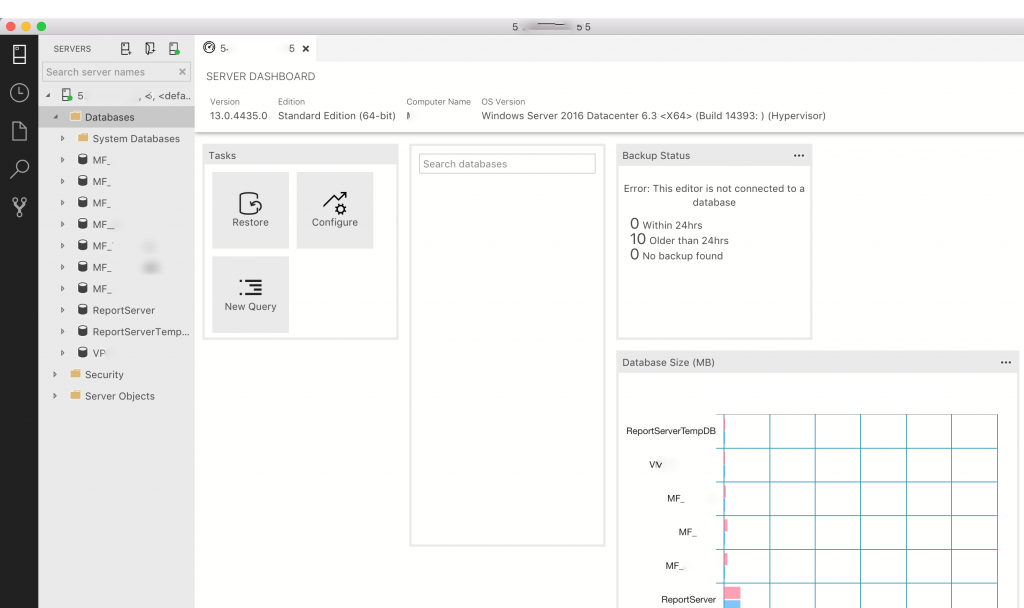
- Microsoft azure data studio how to#
- Microsoft azure data studio software#
- Microsoft azure data studio code#
- Microsoft azure data studio Offline#
The Azure Tables libraries can be downloaded from each languages preferred package manager. Note: The Azure Tables libraries are capable of targeting both Azure Storage Table and Azure Cosmos DB Table API endpoints. The new libraries use the language-specific Azure Core packages for handling requests, errors, and credentials. The new libraries follow our Azure SDK Guidelines, making for an idiomatic, consistent, approachable, diagnosable, and dependable library. The Table storage service can be used to store flexible data sets like user data for web applications, address books, device information, or other types of metadata. The Azure Table service stores NoSQL data in the cloud with a key/attribute store schema-less design.

NET, Java, JavaScript/TypeScript, and Python. You can read a dedicated blog post on this subject, and leave your feedback, requests or suggestions in the comments section.We’re excited to announce that the Azure Tables libraries have been released for. We’re planning to expand our end-to-end developer experience significantly in the future, covering more scenarios and use cases across all phases of the database development workflow.
Microsoft azure data studio how to#
Learn how to setup the new local development experience for Azure SQL Database by following our official documentation, which includes also a step by step quickstart guide to build and publish your first database project. From there, developers and DevOps teams can leverage features like GitHub Actions for publishing a new database or a schema change to a test or production environment in Azure SQL Database public service.
Microsoft azure data studio code#
More extensions covering other areas of the database development process such as design, testing and troubleshooting will be added in the future.ĭatabase projects can be checked in source control systems, such as GitHub repos, together with other code artefacts and projects, providing a true “database as code” experience for designing, implementing and maintaining databases as part of the entire end-to-end solution. In Azure Data Studio, we also provide additional extensions that can support the database development process like Schema Compare, where developers can compare a source and target SQL Project or a live Azure SQL Database running in the emulator or in the public service, verify the differences and even generate a script to reconcile the two. Finally, it supports publishing these projects to the local emulator for further testing and validation and, once passed, to a new or existing logical server in Azure SQL Database public service. SQL Database Project extension supports developers in creating their database projects, building and validating schemas and other objects against Azure SQL Database syntax and capabilities. It can also be used to point to an existing database and generate a SQL Database Project that can be used for subsequent modifications.



The former manages all connection aspects with Azure SQL Database emulator and public service, and lets developers to browse and query local and remote databases. Key extensions for the local development experience are mssqland SQL Database Project.
Microsoft azure data studio Offline#
Local development experience for Azure SQL Database includes a series of extensions for Visual Studio Code and Azure Data Studio and a new Azure SQL Database emulator that lets developers to publish and run their database projects locally, on a containerised, cross-platform emulator providing close fidelity with Azure SQL Database public service while enabling a complete offline experience for running and testing their databases.Įnd to end database development experience. Modern database development follows a similar path, but it requires some specific capabilities as we’re dealing with a rich, fully stateful service like a relational database system for hosting our artefacts (database schema, functions, procedures, index definitions, etc.).Īt Build 2022 We are introducing a local development experience for Azure SQL Databaseas a key building block in supporting database developers across the inner and outer loops of their database development workflows. In contrast, the “outer loop” kicks off as soon as that code is checked in a source control system from where CI/CD pipelines can manage all required steps (including testing and validation) to publish code artefacts and configuration to production systems.
Microsoft azure data studio software#
The “inner loop” in software development workflows is the process of writing, building, debugging and testing code, usually on a local workstation or development environment, before sharing it with someone else.


 0 kommentar(er)
0 kommentar(er)
